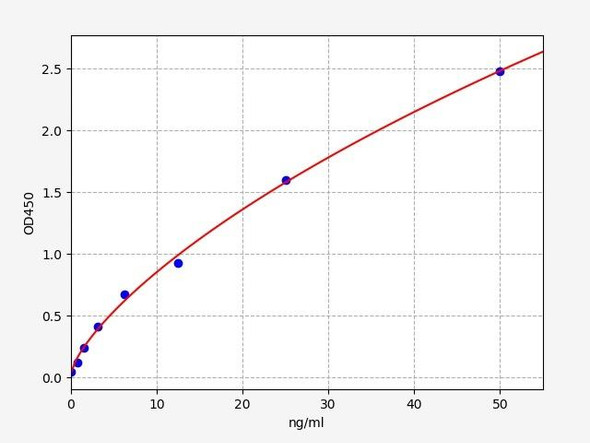Signal Transduction Antibodies 1
Anti-GRIK1 Antibody (CAB10475)
- SKU:
- CAB10475
- Product Type:
- Antibody
- Reactivity:
- Mouse
- Host Species:
- Rabbit
- Isotype:
- IgG
- Antibody Type:
- Polyclonal Antibody
- Research Area:
- Signal Transduction
Description
| Antibody Name: | Anti-GRIK1 Antibody |
| Antibody SKU: | CAB10475 |
| Antibody Size: | 20uL, 50uL, 100uL |
| Application: | WB |
| Reactivity: | Mouse |
| Host Species: | Rabbit |
| Immunogen: | Recombinant fusion protein containing a sequence corresponding to amino acids 859-918 of human GRIK1 (NP_000821.1). |
| Application: | WB |
| Recommended Dilution: | WB 1:500 - 1:2000 |
| Reactivity: | Mouse |
| Positive Samples: |
| Immunogen: | Recombinant fusion protein containing a sequence corresponding to amino acids 859-918 of human GRIK1 (NP_000821.1). |
| Purification Method: | Affinity purification |
| Storage Buffer: | Store at -20'C. Avoid freeze / thaw cycles. Buffer: PBS with 0.02% sodium azide, 50% glycerol, pH7.3. |
| Isotype: | IgG |
| Sequence: | YKSR KNND IEQA FCFF YGLQ CKQT HPTN STSG TTLS TDLE CGKL IREE RGIR KQSS VHTV |
| Gene ID: | 2897 |
| Uniprot: | P39086 |
| Cellular Location: | Cell junction, Cell membrane, Multi-pass membrane protein, postsynaptic cell membrane, synapse |
| Calculated MW: | 102kDa/103kDa |
| Observed MW: | Refer to Figures |
| Synonyms: | GRIK1, EAA3, EEA3, GLR5, GLUR5, GluK1, gluR-5, kainate 1 |
| Background: | Glutamate receptors are the predominant excitatory neurotransmitter receptors in the mammalian brain and are activated in a variety of normal neurophysiologic processes. This gene product belongs to the kainate family of glutamate receptors, which are composed of four subunits and function as ligand-activated ion channels. The subunit encoded by this gene is subject to RNA editing (CAG->CGG; Q->R) within the second transmembrane domain, which is thought to alter the properties of ion flow. Alternative splicing, resulting in transcript variants encoding different isoforms, has been noted for this gene. |
| UniProt Protein Function: | GluR5: Ionotropic glutamate receptor. L-glutamate acts as an excitatory neurotransmitter at many synapses in the central nervous system. Binding of the excitatory neurotransmitter L- glutamate induces a conformation change, leading to the opening of the cation channel, and thereby converts the chemical signal to an electrical impulse. The receptor then desensitizes rapidly and enters a transient inactive state, characterized by the presence of bound agonist. May be involved in the transmission of light information from the retina to the hypothalamus. Belongs to the glutamate-gated ion channel (TC 1.A.10.1) family. GRIK1 subfamily. 2 isoforms of the human protein are produced by alternative splicing. |
| UniProt Protein Details: | Protein type:Membrane protein, integral; Membrane protein, multi-pass; Channel, ligand-gated Chromosomal Location of Human Ortholog: 21q22.11 Cellular Component: presynaptic membrane; postsynaptic membrane; kainate selective glutamate receptor complex; integral to plasma membrane; dendrite; plasma membrane; cell junction Molecular Function:extracellular-glutamate-gated ion channel activity; kainate selective glutamate receptor activity Biological Process: synaptic transmission, glutamatergic; nervous system development; regulation of synaptic transmission, glutamatergic; central nervous system development; glutamate signaling pathway; positive regulation of synaptic transmission, GABAergic; negative regulation of synaptic transmission, glutamatergic; regulation of inhibitory postsynaptic membrane potential; synaptic transmission; behavioral response to pain; transport; ionotropic glutamate receptor signaling pathway; adult behavior; regulation of excitatory postsynaptic membrane potential; positive regulation of gamma-aminobutyric acid secretion |
| NCBI Summary: | Glutamate receptors are the predominant excitatory neurotransmitter receptors in the mammalian brain and are activated in a variety of normal neurophysiologic processes. This gene product belongs to the kainate family of glutamate receptors, which are composed of four subunits and function as ligand-activated ion channels. The subunit encoded by this gene is subject to RNA editing (CAG->CGG; Q->R) within the second transmembrane domain, which is thought to alter the properties of ion flow. Alternative splicing, resulting in transcript variants encoding different isoforms, has been noted for this gene. [provided by RefSeq, Jul 2008] |
| UniProt Code: | P39086 |
| NCBI GenInfo Identifier: | 729597 |
| NCBI Gene ID: | 2897 |
| NCBI Accession: | P39086.1 |
| UniProt Secondary Accession: | P39086,Q13001, Q86SU9, |
| UniProt Related Accession: | P39086 |
| Molecular Weight: | 102,631 Da |
| NCBI Full Name: | Glutamate receptor ionotropic, kainate 1 |
| NCBI Synonym Full Names: | glutamate receptor, ionotropic, kainate 1 |
| NCBI Official Symbol: | GRIK1 |
| NCBI Official Synonym Symbols: | EAA3; EEA3; GLR5; GLUR5; GluK1 |
| NCBI Protein Information: | glutamate receptor ionotropic, kainate 1; gluR-5; glutamate receptor 5; excitatory amino acid receptor 3 |
| UniProt Protein Name: | Glutamate receptor ionotropic, kainate 1 |
| UniProt Synonym Protein Names: | Excitatory amino acid receptor 3; EAA3; Glutamate receptor 5; GluR-5; GluR5 |
| Protein Family: | Glutamate receptor ionotropic |
| UniProt Gene Name: | GRIK1 |
| UniProt Entry Name: | GRIK1_HUMAN |






